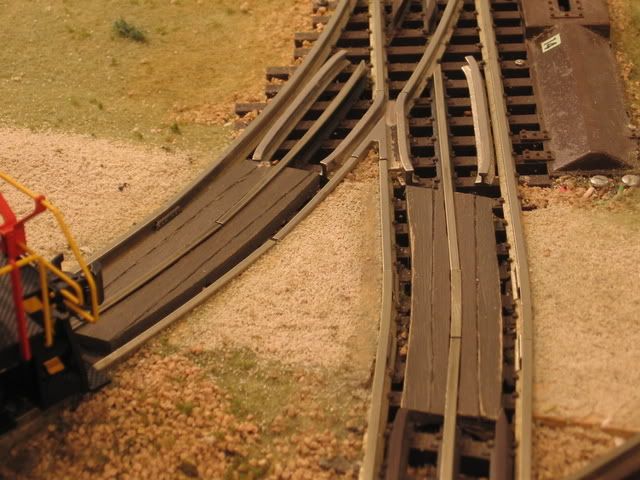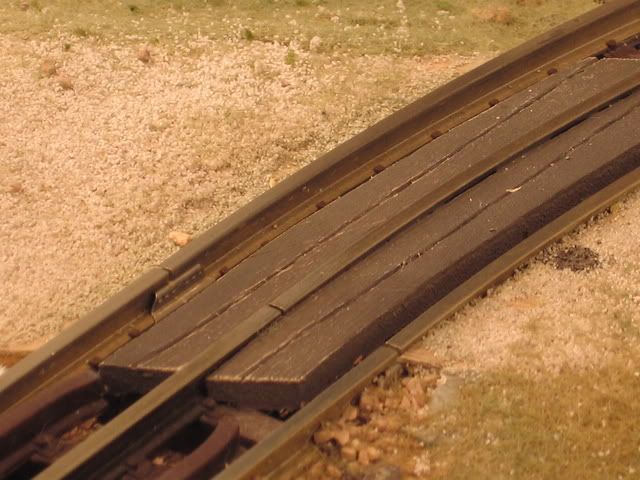What I like about this forum is the knowledge and ideas I gain because others share information. I try to do my part by posting my experiences. Toward that end, I think the most important to share are the failures - what doesn't work: I am removing the “custom built” ‘Streets road I was making from Atlas track.
The whole purpose was to build roads using Atlas track, with 27” and 31” diameters in the curved sections, was so I could have country highways with wider radius turns, both to look a bit more “interstate like” than the sharp curves of standard'Streets track, and to make it easier for long home-made 18 wheeler tractor trailers to negotiate curves by making those curves less sharp. I'm posting this foranyone interested but mainly for the folks that were following this work. For others, this is a link to a posting only a week ago in which I was still enthusiastic about the idea and went over it in detail:
https://ogrforum.com/d...nt/14382474776975661
And it does work: ‘Streets vehicles run perfectly on the forty lane-feet I have completed. But I am convinced it is not going to look that good, ever.
The picture below shows the original idea (see the link above for more details) and a very blown up photo of the problem. For a variety of reasons, it is practically impossible to get the road inserts perfectly level and even - so they look good – like a road surface should. Part of this is that it's just very difficult to cut, trim, and bend each insert to fit perfectly – but I did okay there.
The major problem is that balsa or basswood or Luann plywood or mat-board of foamboard even warps just slightly – not much, and each in their own way maybe (mat-board curls, foamboard “fuzzes” on the edges, but each enough (see the picture of balsa) so it looks bad. No matter what type of glue I try, too. It's only a tiny bit of warping, curling, or twisting, but that is all it takes. FRom any closer than five of six feet, you can see the unevenness, etc. My country road is within two feet of the edge of the layout, and worse, opposite -- across a 28" wide aisle, from the downtown area with its 'Streets-builtcity streets right near the layout edge, which look just like, well . . . roads, and thus set a pretty high standard.
Yes, I can use 1/10 inch thick styrene instead – but the wood or foamboard, etc., was desirable because I could sand high spots and fill low spots easily and widen flange groves easily with sandpaper. Plastic is more difficult to work with.
I tried an alternative plan: various clays or fillers: the idea here being to press something like a fine clay between the rails, use a roller to push it and smooth it to just below rail level, then as it began to harden, cut narrow groves for the wheel flanges out. A workable idea and I experimented over the earlier part of this week with seven types of clay on ten inches of “road” each type. Playdough doesn’t work (twists, crumbles, won’t cling). Modeling clay (oil base) doesn’t work either (stays oily, nearly impossible to paint although you can – sort of), nor does papier mache’ or Crayola brand air-dried clay work much better. But three “clays” did work: Paperclay ( a fine air-drying clay made for sculptors that is maybe half paper or paper mache or Critter Clay (also air dried) as used by taxidermists and finally the best of the lot, Apoxie Sculpt, a two-part mixable epoxy-like modeling/sculpter clay, that does not shrink or crack at all and hardens in three hours But all three cost quite a bit, and worst, they dry/harden with an uneven surface knobbly surface even if it’s even and smooth when I smooth it out while the clay is still wet or pliable. And yes, you can sand and fill all three when dried – or fill and sand the warped balsa or bassword for that matter. So with enough time, effort, filler, sanding, and tedium, just about any of these could be made to work. But it would take forwever and I am fairly certain the results would not look quite a ssmooth and even as "factory" road.
So, I will re-design my country road to use standard EZ-Streets, and just make sure my home-built ‘Streets tractor trailers, etc., can negotiate D21” curves. It will work out okay.
I agree with people who say you learn from your mistakes. I’ve learned a lot in the last week.









